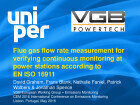Air monitoring
Flue gas flow rate measurement for verifying continuous monitoring at power stations according to EN ISO 16911
May 24 2018
Author: David Graham on behalf of CEM Conference
The relatively new European standard for measuring fl ue gas fl ow rate, EN ISO 16011 Parts 1 and 2, specifi es Quality Assurance requirements for continuous flow monitoring at, for example, large combustion and incineration plant.
When the flue gas fl ow rate is measured, as is usually the case for incineration plant, the fl ow monitor must be calibrated, according to Part 2 of the standard, using the Standard Reference Method (SRM), defi ned in Part 1 of the standard (which allows the use of both velocity and tracer measurement techniques). The calibration follows the basic approach defined in EN 14181 which defi nes three Quality Assurance Levels (QAL1, QAL2 and QAL3) and an Annual Surveillance Test (AST). QAL2 defines this initial calibration of the flow monitor, performed by an accredited Test Laboratory, and the AST defi nes the annual calibration check, also conducted by the Test Laboratory. However, the performance criteria specifi ed in EN 14181 for all of the Quality Assurance Levels are modifi ed by EN ISO 16911 to be suitable for fl ow
measurement.
When the flue gas flow rate is calculated from fuel consumption, according to Part 1 (Annex E) of the standard, as is usually the case for large combustion plant that fire well characterised fuels, the flow calculation must also be verifi ed using the SRM. However, the QA requirements for this verification are less explicitly defined. This paper describes the results of a VGB research project aimed at providing further guidance on the implementation of EN ISO 16911 when the plant monitoring is based on calculation.
Field trials at a coal fired power station and a gas turbine installation are described and analysed using the QAL2 and AST approaches. The coal fired power station has a wet stack and the gas turbine has a high temperature exhaust which present challenges to both velocity and tracer injection methods that were not explored during the CEN field trial validation of the standard.
For the purposes of verifi cation of fl ow calculation, it is proposed that a combination of statistics from the AST (absolute deviation) and QAL2 (variability) is employed. With regards to the fi eld trials, all of the measurement techniques were acceptable and a QAL2/AST pass was obtained with all except one of the data sets. However, the data from tracer injection and 3D Pitot velocity measurements were the closest to the calculated plant fl ow rates in both cases.
Recommendations are also made with regards to ongoing Quality Assurance (QAL3) for large combustion plant.
Digital Edition
IET 35.2 March
April 2025
Air Monitoring - Probe Sampling in Hazardous Areas Under Extreme Conditions - New, Game-Changing Sensor for Methane Emissions - Blue Sky Thinking: a 50-year Retrospective on Technological Prog...
View all digital editions
Events
Apr 21 2025 Shanghai, China
Apr 22 2025 Hammamet, Tunisia
Apr 22 2025 Kintex, South Korea
Analytica Anacon India & IndiaLabExpo
Apr 23 2025 Mumbai, India
Apr 23 2025 Moscow, Russia






_(4427399123)-(2).jpg)








